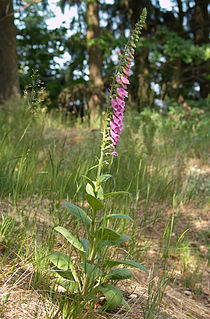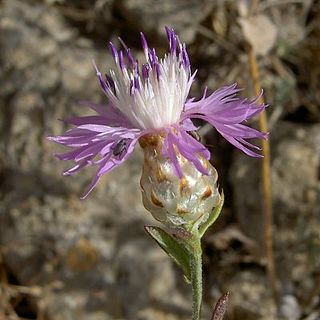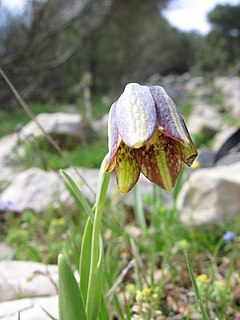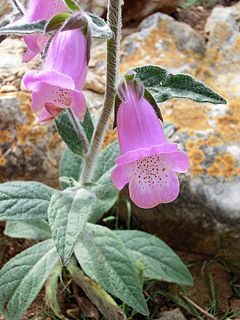
Digitalis is a genus of about 20 species of herbaceous perennial plants, shrubs, and biennials, commonly called foxgloves.

Digitalis purpurea, the foxglove or common foxglove, is a species of flowering plant in the plantain family Plantaginaceae, native to and widespread throughout most of temperate Europe. It has also naturalised in parts of North America and some other temperate regions. The plant is a popular garden subject, with many cultivars available. It is the original source of the heart medicine digoxin. This biennial plant grows as a rosette of leaves in the first year after sowing, before flowering and then dying in the second year. It generally produces enough seeds, however, so that new plants will continue to grow in a garden setting.

Ballota nigra, the black horehound, is a perennial herb of the family Lamiaceae. It is native to the Mediterranean region and to central Asia and it can be found throughout Europe. It is also naturalized in Argentina, New Zealand, and the Eastern United States. It blooms in the Northern Hemisphere from May to August.

Dianthus superbus, the fringed pink or large pink, is a species of Dianthus native to Europe and northern Asia, from northernmost Spain and France north to arctic Norway, and east to Japan; in the south of its range, it occurs at high altitudes, up to 2,400 m.

Vinca major, with the common names bigleaf periwinkle, large periwinkle, greater periwinkle and blue periwinkle, is a species of flowering plant in the family Apocynaceae, native to the western Mediterranean. Growing to 25 cm (10 in) tall and spreading indefinitely, it is an evergreen perennial, frequently used in cultivation as groundcover.

Erysimum nevadense is a perennial short-lived herb endemic to the Sierra Nevada of Spain, although there are some citations in the nearby Sierra de Gádor (Almería). This wallflower occurs between 1,700 and 2,700 m above sea level in subalpine scrublands and alpine meadows. It may be treated as a narrowly circumscribed single species, one of a group or complex of six separate species, or as a more broadly circumscribed species with six subspecies.

Echinops sphaerocephalus, known by the common names glandular globe-thistle, great globe-thistle or pale globe-thistle, is a Eurasian species of globe-thistle belonging to the thistle tribe within the sunflower family.

Silene campanulata is a species of flowering plant in the family Caryophyllaceae known by the common names Red Mountain catchfly and bell catchfly. It may be a synonym of Silene greenei.

Adenanthos glabrescens is a species of small shrub endemic to the Ravensthorpe area in southwest Western Australia. First published in 1978, there are two subspecies.

Digitalis thapsi, which has been called mullein foxglove in the US, is a flowering plant in the genus Digitalis that is endemic to the Iberian Peninsula, where it occurs in eastern Portugal and central and western Spain. It is of commercial importance as an ornamental plant. Hybrids with D. purpurea have proved successful and are fertile.

Hakea laevipes is a shrub in the family Proteaceae. A widespread species found growing on coastal and tableland locations mainly in eastern New South Wales, with scattered populations in south-eastern Queensland.

Agalinis paupercula, commonly known as the smallflower false foxglove, is a hemiparasitic annual plant native to the eastern parts of the United States and Canada. Found in open, moist areas, its purple flowers are borne on a 30-to-70-centimeter stem, and bloom in August and September. The species has often been treated as a variety of Agalinis purpurea, the purple false foxglove, and preliminary genetic evidence suggests that the two are, in fact, a single species.
Allium curtum is species of flowering plant in the amaryllis family, Amaryllidaceae. It is native to Cyprus, Egypt, Lebanon, Palestine, the Sinai Peninsula, Syria and Turkey. It is a bulb-forming perennial producing a tight, head-like umbel of green or purple flowers.

Centaurea alba is a species of Centaurea found in the Iberian Peninsula in southern and central Spain and in a small neighbouring area in the interior of Portugal. There are three recognised subspecies, and of one subspecies, the nominate, there are furthermore three varieties.

Fritillaria crassifolia is a Middle Eastern species of bulb-forming flowering plant in the lily family Liliaceae, native to Iran, Iraq, Turkey, Syria, and Lebanon.

Microcnemum is a genus in the plant family Amaranthaceae, containing a single species, Microcnemum coralloides. It is a dwarf annual halophyte with fleshy, apparently jointed stems and reduced leaves and flowers. The two subspecies show a disjunct distribution in Spain and Western Asia.

Scaevola basedowii is an erect multi-stemmed shrub in the family Goodeniaceae, endemic to Western Australia, the Northern Territory and South Australia.
Digitalis transiens is a species of flowering plant in the family Plantaginaceae which is endemic to Morocco. It was recently also classified as a synonym of D. subalpina. It has yellow flowers with woolly hairs on its lip and throat, the corolla length is 11 to 13mm.

Digitalis minor is a species of flowering plant in family Plantaginaceae, which has been called dwarf Spanish foxglove. It is a biennial or short-lived perennial species of foxglove which is endemic to the Balearic islands with large, pendulous, pink or purple flowers. Closely related to the common purple foxglove, it is best distinguished by its small fruits. It is one of the only foxgloves to grow in calciferous, alkaline soils.
Digitalis cariensis is a species of flowering plant in family Plantaginaceae. It is a type of foxglove. It is native from southwestern to southern Turkey.

















